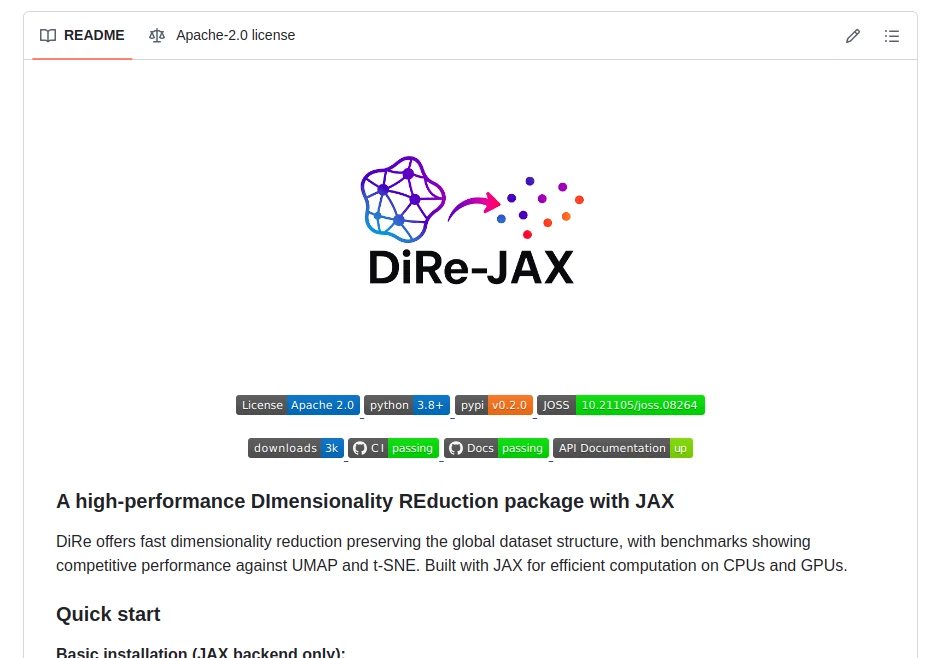DiRe-JAX
Fast Dimensionality Reduction in JAX

What is DiRe-JAX?
Dire-JAX steps in as a nimble toolkit for squeezing high-dimensional data down to sizes that reveal patterns without losing the big picture. Built on the JAX framework, it tackles clustering and visualization tasks with a focus on speed and structure preservation, making it a hit among data explorers who juggle complex datasets on the fly. Early adopters from research circles have leaned on it to turn tangled feature sets into clear maps, often sharing how it shaved hours off their usual routines.
Introduction
Dire-JAX sprang from a drive to blend JAX's raw speed with smarter ways to handle data sprawl, kicking off as an open project to fill gaps in quick-reduction tools. It hit the scene aiming at folks knee-deep in exploratory analysis, where spotting clusters amid noise can make or break insights. Over time, tweaks from community nudges have honed its edge, drawing in users who value how it keeps the dataset's overall shape intact while zipping through computations. What started as a bench against classics like UMAP and t-SNE has grown into a go-to for those chasing reliable shortcuts in data wrangling, backed by a working paper that dives into its nuts and bolts.
Key Features
User Interface
Getting around feels straightforward, with a core class that takes in data and spits out transforms via simple method calls—no steep menus or hidden toggles. Examples in notebooks guide you from raw blobs to plotted outcomes in a handful of lines, keeping the code flow clean like a well-thumbed script. Even if you're scripting in a fresh environment, the params slot in naturally, letting you tweak neighbors or spreads without flipping through docs mid-stream.
Accuracy & Performance
It holds its own against established players, nailing down layouts that echo the original data's flow, with benchmarks showing it pulls ahead on time without skimping on fidelity. On everyday machines, it flies through batches under fifty thousand points, and hooking up a GPU turns it into a speed demon for repeated runs. Folks running the included checks often nod at how it stays steady, churning out consistent views even when datasets throw curveballs like uneven clusters.
Capabilities
The heart of it lies in folding vast feature spaces into compact spreads, whether you're eyeing two dimensions for a scatter plot or more for deeper digs. It juggles init tricks like PCA to kick off smartly, and extras like homology checks let you gauge how well it captures holes and loops in the data. Vectorized under the hood, it scales from toy examples to real-world hauls, with hooks for custom metrics to fine-tune your take on quality.
Security & Privacy
As a pure code package, it keeps things local on your setup, with no calls home or data shares baked in, so your numbers stay yours from crunch to close. The open license invites eyes on the workings, and standard JAX guards mean you're shielded from common pitfalls like unchecked inputs. Users rest easy knowing it's built for trust, especially in sensitive fields where leaks aren't an option.
Use Cases
Researchers plot gene expressions to spot groupings that hint at pathways, turning raw reads into telling clusters overnight. Marketers slice customer profiles for targeted campaigns, mapping behaviors into visuals that spotlight niches. In labs, it helps sift sensor floods from experiments, preserving the experiment's arc for quicker write-ups. Even hobby coders toy with image sets, reducing pixels to paths that reveal hidden themes without heavy lifts.
Pros and Cons
Pros:
- Blazes through tasks on standard gear, outpacing rivals in quick hits.
- Keeps the data's grand scheme clear, dodging local distortions.
- Plays nice with JAX's ecosystem for seamless extensions.
- Packed with benches to prove its mettle right out of the gate.
Cons:
- Tuned for smaller loads, so big data might need batching tricks.
- Relies on JAX know-how, which could trip up fresh faces.
- Light on built-in plots, pushing you to pair with viz pals.
Pricing Plans
True to its open roots, Dire-JAX comes at no cost, with pip pulls grabbing the lot for free, whether you stick to basics or snag the full utils bundle. No tiers or upsells—just download, tweak, and run, backed by a license that lets you fork and fix as needed. For those eyeing extras, the optional bits layer on without a dime, keeping the barrier low for tinkerers and teams alike.
How to Use Dire-JAX
Start by pip-ing the package, then fire up a script to import the DiRe bit and whip up some sample blobs for a test drive. Set your components and neighbor count, fit on your features, and transform to get the slimmed view—plot it quick to see the spread. Dive into params for spreads or iters if the first pass needs polish, and lean on the notebook for scaling tips when your data grows.
Comparison with Similar Tools
Against UMAP's local leans, Dire-JAX bets on global grips for broader overviews, though that one might edge in dense packs. t-SNE shines for tiny peeks but drags on scale, where this JAX whiz keeps pace without the wait. It carves space for speed demons who code, blending ease with power where others tip toward point-and-click or pure math.
Conclusion
Dire-JAX wraps up the hunt for swift data shrinks by leaning on JAX's muscle to deliver views that stick to the source's soul. It empowers questers to uncover stories in sprawls without the slog, fostering finds that fuel fresh paths. As data keeps piling higher, this gem holds steady, inviting coders to build bolder with every run.
Frequently Asked Questions (FAQ)
What's the sweet spot for dataset sizes?
It hums best under fifty thousand points, but batches handle bigger bites.
Does it need a GPU to shine?
Nah, CPU crunches fine, but graphics cards kick it into overdrive.
How do I measure if it's working right?
Grab the utils for metrics, or eye the plots against your gut feel.
Can I tweak the starting point?
Yep, swap in PCA or random for inits that suit your spread.
Is there a way to contribute fixes?
Fork away—the guide walks you through pulls and tests.
AI Data Mining , AI Research Tool , AI Developer Tools , Other , Github Repos .
These classifications represent its core capabilities and areas of application. For related tools, explore the linked categories above.
DiRe-JAX details
This tool is no longer available; find alternatives on Alternative to DiRe-JAX.
Pricing
- Free
Apps
- Web Tools
















